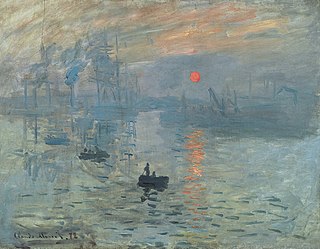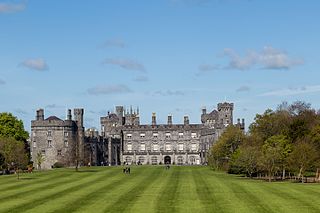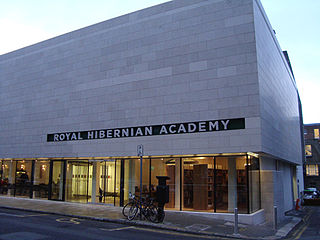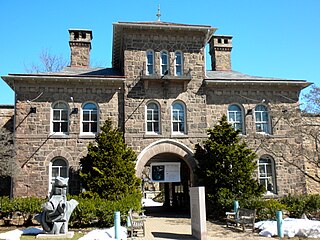
Impressionism was a 19th-century art movement characterized by relatively small, thin, yet visible brush strokes, open composition, emphasis on accurate depiction of light in its changing qualities, ordinary subject matter, unusual visual angles, and inclusion of movement as a crucial element of human perception and experience. Impressionism originated with a group of Paris-based artists whose independent exhibitions brought them to prominence during the 1870s and 1880s.

Kilkenny is a city in County Kilkenny, Ireland. It is located in the South-East Region and in the province of Leinster. It is built on both banks of the River Nore. The 2022 census gave the population of Kilkenny as 27,184, the thirteenth-largest urban center in Ireland.

Post-Impressionism was a predominantly French art movement that developed roughly between 1886 and 1905, from the last Impressionist exhibition to the birth of Fauvism. Post-Impressionism emerged as a reaction against Impressionists' concern for the naturalistic depiction of light and colour. Its broad emphasis on abstract qualities or symbolic content means Post-Impressionism encompasses Les Nabis, Neo-Impressionism, Symbolism, Cloisonnism, the Pont-Aven School, and Synthetism, along with some later Impressionists' work. The movement's principal artists were Paul Cézanne, Paul Gauguin, Vincent van Gogh and Georges Seurat.

The Royal Hibernian Academy of Arts (RHA) is an artist-based and artist-oriented institution in Ireland, founded in Dublin in 1823. Like many other Irish institutions, such as the Royal Irish Academy, the academy retained the word "Royal" after most of Ireland became independent as the Irish Free State in December 1922.

Kinetic art is art from any medium that contains movement perceivable by the viewer or that depends on motion for its effects. Canvas paintings that extend the viewer's perspective of the artwork and incorporate multidimensional movement are the earliest examples of kinetic art. More pertinently speaking, kinetic art is a term that today most often refers to three-dimensional sculptures and figures such as mobiles that move naturally or are machine operated. The moving parts are generally powered by wind, a motor or the observer. Kinetic art encompasses a wide variety of overlapping techniques and styles.

Thomastown, historically known as Grennan, is a town in County Kilkenny in the province of Leinster in the south-east of Ireland. It is a market town along a stretch of the River Nore which is known for its salmon and trout, with a number of historical landmarks in the vicinity. Visitor attractions include Jerpoint Abbey, Kilfane Glen gardens, and Mount Juliet Golf Course. The town is in a civil parish of the same name. As of the 2022 census, Thomastown had a population of 2,305, making the town the third most populous in the county.

Neo-Impressionism is a term coined by French art critic Félix Fénéon in 1886 to describe an art movement founded by Georges Seurat. Seurat's most renowned masterpiece, A Sunday Afternoon on the Island of La Grande Jatte, marked the beginning of this movement when it first made its appearance at an exhibition of the Société des Artistes Indépendants in Paris. Around this time, the peak of France's modern era emerged and many painters were in search of new methods. Followers of Neo-Impressionism, in particular, were drawn to modern urban scenes as well as landscapes and seashores. Science-based interpretation of lines and colors influenced Neo-Impressionists' characterization of their own contemporary art. The Pointillist and Divisionist techniques are often mentioned in this context, because they were the dominant techniques in the beginning of the Neo-Impressionist movement.

Irish art is art produced in the island of Ireland, and by artists from Ireland. The term normally includes Irish-born artists as well as expatriates settled in Ireland. Its history starts around 3200 BC with Neolithic stone carvings at the Newgrange megalithic tomb, part of the Brú na Bóinne complex which still stands today, County Meath. In early-Bronze Age Ireland there is evidence of Beaker culture and widespread metalworking. Trade-links with Britain and Northern Europe introduced La Tène culture and Celtic art to Ireland by about 300 BC, but while these styles later changed or disappeared elsewhere under Roman subjugation, Ireland was left alone to develop Celtic designs: notably Celtic crosses, spiral designs, and the intricate interlaced patterns of Celtic knotwork.
Tony O'Malley was an Irish artist known for painting. He was born in Callan, County Kilkenny, Ireland. O'Malley was a self-taught artist, having drawn and painted for pleasure from childhood. He worked as a bank officìal until contracting tuberculosis in the 1940s. He began painting in earnest while convalescing and, though he did at first return to bank work, he continued to paint and in 1951 he began exhibiting his work.
Samuel Walsh is an Irish abstract artist. He is a member of Aosdána, founder of the National Collection of Contemporary Drawing and is closely associated with the beginnings of EVA International. Born in London in 1951 to Irish parents, he moved to Limerick, Ireland in 1968, where he resided until 1990. He now lives and works in Co. Clare.
Fergus Martin is an Irish painter, and a member of Irish artistic academy Aosdána since 2001.

The Michener Art Museum is a private, non-profit museum that is located in Doylestown, Bucks County, Pennsylvania. Founded in 1988, it was named for the Pulitzer Prize–winning writer James A. Michener, a Doylestown resident.

Everett Longley Warner was an American Impressionist painter and printmaker, as well as a leading contributor to US Navy camouflage during both World Wars.

Butler Gallery is a contemporary art gallery and museum in Kilkenny, Ireland. It presents a collection of works by Irish and international artists from the 18th century to the present day. A wing has been devoted to the work of the Callan artist Tony O'Malley and his wife Jane.

Kilkenny College is a Church of Ireland co-educational day and boarding secondary school located in Kilkenny, in the South-East of Ireland. It is the largest co-educational boarding school in Ireland. In 2013 it transferred to the state/public sector and no longer charges fees for schooling. The school's students are mainly Protestant, although it is open to other denominations.

The visual arts are art forms such as painting, drawing, printmaking, sculpture, ceramics, photography, video, filmmaking, comics, design, crafts, and architecture. Many artistic disciplines, such as performing arts, conceptual art, and textile arts, also involve aspects of the visual arts, as well as arts of other types. Also included within the visual arts are the applied arts, such as industrial design, graphic design, fashion design, interior design, and decorative art.
Arild Rosenkrantz was a Danish nobleman painter, sculptor, stained glass artist and illustrator.

Dysart Castle is a castle ruins and property just outside Thomastown in County Kilkenny, Ireland.

The Kilkenny Arts Festival, formally known as Kilkenny Arts Week, was founded in Kilkenny, Ireland, in 1974. It covers a number of art forms, including classical music and performance. Playwright and poet Seamus Heaney gave a reading of some of his works during the inaugural event.

Niamh O'Malley is a contemporary Irish artist known for sculptures and moving image installations. She was elected to membership in Ireland's artistic academy, Aosdána, and represented the country at the 59th Venice Biennale.















